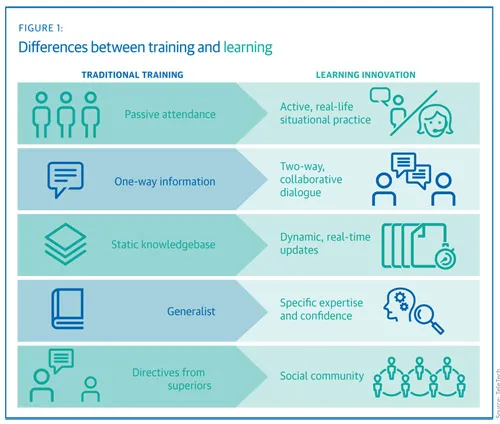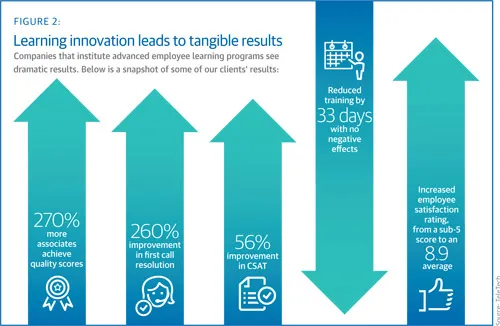For many people, a health insurer’s contact center is their connection to a trusted advisor who can help them answer questions, make decisions, or point them in the right direction. Key to a positive experience is someone on the other end of the line (or screen) who is confident and knowledgeable. With the current state of the industry in such flux, keeping up with the pace of change can be a challenge.
In traditional employee training programs, new hires go through rigorous programs that typically run through the “kitchen sink” of industry, technical, and procedural lessons in a module format. Afterward, they’re placed in an environment where new information is fed to them. When a unique call is fielded, it’s up to the associate to search for relevant materials or call upon their past training. It’s a model that isn’t built for the rapid pace of today’s health insurance world. Contact center employees today need agility and nimbleness when it comes to information and access.
It’s time for a new approach to healthcare contact center learning and development, which features a combination of new strategies, tactics, and tools. First, a cultural change is needed. “Learning” is different than “training.” While training focuses on compliance, competence, and teacher mastery, learning is about continuous excellence and student empowerment. Someone who learns actively and enthusiastically participates in the process, and takes ownership of newfound knowledge and expertise. Real learners aren’t just passive attendees in a training program, memorizing facts and figures that lose relevance when they step onto the live floor.

If done well, employees will consider learning programs as an opportunity to grow personally and professionally, instead of a nuisance that takes time away from their daily activities. They will see what they learn in context, understanding that customer experience and overall business is affected by how they apply what they learn to customer interactions.
The goal of a next-gen learning program is to continuously develop employees who are experts in their field and confident about what they know and how to get the job done. They also understand that they don’t need to know everything, but will have the confidence in their ability to move quickly to find the right information.
Once an organization adopts this mindset, it must hire the right talent through a strategic hiring process. The recruitment process must evolve to align to the contact center’s new role as an advisory interaction channel. Identify the types of skills necessary to meet customer needs in this channel, and recruit to match these needs. Payers may need to recruit new types of employees—those with technical or healthcare industry-specific skills, as well as aptitude for problem solving and empathy, especially for sensitive health or billing issues.
They must then create a learning program that reflects these values. Instead of a kitchen-sink approach, organizations can hone the skills and expertise related to the most common call types, not the most difficult ones. Call data analysis can influence curriculum and process updates. Practice-based learning tools allow employees to become experts and confident in their interactions, and interactive, next-gen simulated learning programs let employees experience different scenarios and build confidence before working with live calls.
For example, employee incentives and gamification reinforce lessons in a fun way. When it comes to the dynamic knowledgebase, employees who complete their onboarding program can receive an initial badge. They then get points toward a new badge or perks for commenting on items in the knowledgebase that their peers or supervisors like and find useful. As an employee’s status improves, he or she may be granted access to write or edit their own content.

An innovative learning organization also includes a “living” knowledgebase for employees to use. The key to a good knowledgebase is not what goes into it, but how it’s designed. Static, text-based training materials are replaced by a dynamic, interactive, searchable knowledge system. Simply designed multimedia content, such as images and video, allow associates to find answers on-the-fly during customer calls, or in other short timeframes. It incorporates employee notes, comments, and updates to create two-way collaboration that increases the relevance and usefulness of information. Triggers and keywords within the first moments of a customer conversation serve up relevant call flows, content, and other data to associates so they are ready with information more quickly.
Each of these aspects creates more effective and efficient customer interactions. Calls are resolved more quickly, repeat calls drop, associate productivity increases, fewer calls are transferred, and customer satisfaction improves.
Five ways to take employee learning to the next level
While it’s important to evolve employee learning and development, it can be a challenging endeavor. We recommend five best practices to help get started on the journey.
1. Look outside the healthcare industry
The “Amazon” effect has changed consumers forever. They expect a positive customer experience with all companies they do business with, regardless of industry. This is a challenge to payers. To catch up, look at how top brands in other industries approach associate learning and development. While healthcare may be unique, your customers are not. They are customers of other industries, too. Tailoring best practices from those industries into healthcare is the key to differentiating yourself. Research where your customers go when they want a “best in class” experience outside of healthcare.
2. Design a program that addresses what’s important to your business
Some companies want to handle calls quickly. Others want to deliver white glove concierge service. While others want to right-channel different types of customer interactions. There is no one “right” way to design a learning program. The key is to identify your organization’s objectives, and set KPIs that match. Then, find the right talent with the right skills to operate in the learning environment you design to reach those objectives. Finally, train to those objectives and KPIs.
3. Focus on the right information
Many companies think that quantity equals quality when it comes to their knowledgebase. What actually happens is that information overload overwhelms people. It’s hard to find relevant information, and a lot of resources are wasted on information that’s never accessed. Instead, learn why people call, when, and what types of resolutions they want. Use tools and practice-based learning to perfect the interactions around these types of calls. Update information often, and remove outdated content. These may require up-front resources, but in the long run it saves time, energy, and improves the experience.
4. Build employee confidence
We can’t stress this enough. A confident workforce makes all the difference to a superior interaction. Design your program to continuously reinforce the right types of employee activity, and allow them to share their insight in the knowledgebase. Train employees on knowledge, but also on how to find information if they don’t know the answer. Information is always changing, especially in healthcare. In some cases it’s more important to know how to find the right information than what the information actually is. On the back-end, make sure all the programs and systems are built with the customer interaction in mind.
5. Incentivize people to continue learning and growing
Learning and development is not a one-and-done event. It must be allowed to grow organically, as the role of the contact center grows and customer interactions change. Allow your employees to grow with it. Incentivize associates to contribute to making the system better, or speak up when it isn’t working well. Emerging programs like gamification add a sense of accomplishment, community, and achievement to employee incentives initiatives.
The health insurance industry changes every day. Payers who can help members and other constituents maneuver through these changes will rise to the top. That’s why it’s so important for the contact center to be staffed with employees who are considered guides and experts, not just traditional associates. Advanced learning and development can help health insurers realize these employee goals, to the benefit of customers and the company. It’s time to move away from traditional training to develop experts who can help consumers throughout their member journey.

















